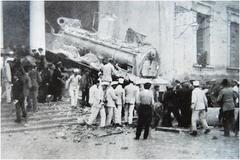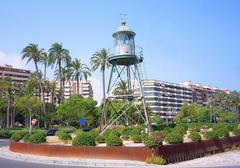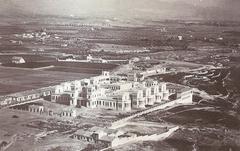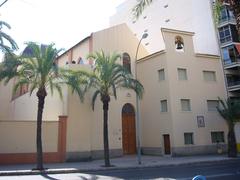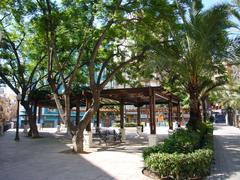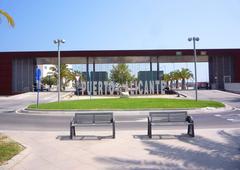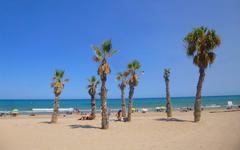Santiago Tower Alicante, Spain: Visiting Hours, Tickets, and History Guide
Date: 14/06/2025
Introduction: Santiago Tower—A Window Into Alicante’s Heritage
Santiago Tower (Torre de Santiago) stands as a resilient emblem of Alicante’s Mediterranean history and its enduring spirit. Built in the 16th and 17th centuries to defend against Barbary corsair raids, this fortified watchtower was part of the celebrated “Las Torres de la Huerta”—a network of towers guarding the fertile plains north of Alicante. Santiago Tower offers visitors unparalleled insight into the city’s defensive architecture and the symbiosis between agricultural prosperity and communal security (Official Alicante Tourism; Castlepedia).
Today, Santiago Tower is a vital cultural landmark within Alicante’s urban landscape, easily accessible and often featured on guided heritage tours. With panoramic rooftop views, well-preserved stonework, and engaging cultural events, the tower connects visitors with Alicante’s layered history. Its proximity to attractions like the Castle of Santa Barbara, Basilica of Santa María, and Explanada de España promenade enriches any visit, making it a must-see on any Alicante itinerary (The Crazy Tourist; Traveltomtom).
This guide presents essential information—visiting hours, ticket details, accessibility, local tips, and suggested routes—ensuring you have a smooth and memorable experience at Santiago Tower.
Table of Contents
- Historical Overview and Evolution
- Architectural Features and Defensive Role
- Socio-Economic and Cultural Significance
- Practical Visitor Information
- Nearby Attractions and Events
- Preservation Efforts and Community Engagement
- Frequently Asked Questions (FAQs)
- Planning Your Visit
Historical Overview and Evolution
Constructed during the 16th and 17th centuries, Santiago Tower was integral to Alicante’s defense against North African pirates. The towers, spaced strategically across the Huerta de Alicante, protected both the city’s agricultural wealth and its people, creating a defensive network that was innovative for its time. Supported by advanced irrigation systems like the Tibi Dam, these towers enabled the prosperity and security necessary for thriving agriculture and commerce (Official Alicante Tourism).
As pirate threats waned, many towers—including Santiago—were repurposed for residential or agricultural uses, symbolizing Alicante’s adaptability and resilience.
Architectural Features and Defensive Role
Santiago Tower rises 2–3 stories, with thick masonry walls and narrow, slit-like windows for protection and surveillance. The robust stonework, single elevated entrance, and removable staircases were all designed to withstand sieges. The rooftop platform provided long-range coastal views, and some towers were equipped with bells for signaling. These features made the towers highly effective in preventing raids and safeguarding the region (Castlepedia).
Socio-Economic and Cultural Significance
The network of towers, including Santiago, reflects a period when community cooperation was vital for survival. Their construction and upkeep were communal efforts, emphasizing the intertwining of defense, agriculture, and social cohesion. Today, the towers are cherished cultural landmarks, serving as venues for educational programs, local festivals, and heritage events (Alicante Heritage Foundation).
Practical Visitor Information
Visiting Hours and Tickets
- Opening Hours: Santiago Tower is typically open from 10:00 AM to 6:00 PM, Tuesday to Sunday. Hours may vary seasonally or during public holidays, so check ahead via the official tourism website or local office.
- Tickets: Entrance is generally free if viewing from public areas, as the tower is often on private land. Guided tours, offered by heritage organizations, may cost between €5 and €10.
- Guided Tours: Available through local operators, especially on weekends or during festivals. Advance booking is recommended in peak seasons (Spain Info).
Accessibility and Location
- Location: Situated in the San Juan district, about 7 km north of Alicante’s city center, at Plaza de la Santísima Trinidad, 1, 03012 Alicante.
- Getting There: Accessible by car, bicycle, or public transport (bus lines 21 and 22). Parking is available near trailheads.
- Accessibility: The historic structure has steep, narrow stairs and no elevators. Interior access may be limited for those with mobility challenges, but the exterior can be enjoyed from accessible paths (Planetware).
Recommended Routes and Visitor Tips
- The “Las Torres de la Huerta” trail covers approximately 12 km and is ideal for cyclists or walkers (2–3 hours).
- Spring and autumn are the best seasons to visit.
- Bring water, sun protection, and a GPS/map.
- Respect private property boundaries along the route.
Nearby Attractions and Events
- Castle of Santa Barbara: One of Spain’s largest medieval fortresses, offering panoramic views over Alicante.
- Explanada de España: A palm-lined promenade perfect for a leisurely walk.
- Basilica of Santa María: Alicante’s oldest church, showcasing Gothic architecture.
- Local Festivals: Cultural events, historical reenactments, and art exhibitions often take place at or near Santiago Tower, especially during Hogueras de San Juan and the Moors and Christians Festival (Alicante Events Calendar; thetouristchecklist.com).
Preservation Efforts and Community Engagement
Santiago Tower is maintained through the combined efforts of municipal authorities, heritage groups, and volunteers. Restoration projects prioritize traditional materials and minimal intervention, ensuring authenticity. Informational plaques in several languages enrich the visitor experience, and the tower regularly hosts educational and community events. Local schools and universities use the site for hands-on history and archaeology activities, fostering a sense of stewardship among younger generations (Castlepedia).
Frequently Asked Questions (FAQs)
Q: What are Santiago Tower’s visiting hours?
A: Generally 10:00 AM to 6:00 PM, Tuesday to Sunday. Confirm before visiting, as hours may change.
Q: Is there an entrance fee?
A: Viewing from public areas is usually free. Guided tours may cost €5–€10.
Q: Are guided tours available?
A: Yes, especially on weekends and during festivals; booking ahead is advised.
Q: Is the tower wheelchair accessible?
A: The ground level is accessible, but upper floors, reached via steep stairs, are not.
Q: How do I reach Santiago Tower from the city center?
A: By bus (lines 21 or 22), car, or bicycle. Walking from the Explanada de España is also possible.
Q: Are there restroom facilities?
A: None on-site, but public restrooms and cafés are nearby in the old town.
Q: Can I take photos?
A: Yes, photography is permitted; drones are restricted.
Plan Your Visit
To maximize your experience:
- Combine your visit with nearby landmarks such as Castle of Santa Barbara and the Explanada de España for a full day of exploration.
- Visit in spring or autumn for optimal weather and fewer crowds.
- Download the Audiala app for interactive maps, up-to-date guides, and event notifications.
- Respect the heritage site and help preserve it for future generations.
For current hours, events, and detailed route maps, consult the Official Alicante Tourism site.
References
- Official Alicante Tourism
- Castlepedia
- The Crazy Tourist
- Traveltomtom
- Planetware
- Spain Info
- Alicante Events Calendar
- thetouristchecklist.com
